 Radhanath Swami’s parents Gerald and Idelle Slavin expressed their faith in God through acts of kindness and gratitude. Having survived the hardships of the Depression of 1930s, his parents worked hard and arranged the best for Richie (childhood name of Radhanath Swami) and his brothers. They were also careful not to spoil Richie and taught him to thank God for all the gifts bestowed upon him. Radhanath Swami’s grandfather William Bill Slavin, in particular, left a deep impression in little Richie’s life; his unassuming and quiet way of harmonizing his old-world traditions with life in America fascinated little Richie.
Radhanath Swami’s parents Gerald and Idelle Slavin expressed their faith in God through acts of kindness and gratitude. Having survived the hardships of the Depression of 1930s, his parents worked hard and arranged the best for Richie (childhood name of Radhanath Swami) and his brothers. They were also careful not to spoil Richie and taught him to thank God for all the gifts bestowed upon him. Radhanath Swami’s grandfather William Bill Slavin, in particular, left a deep impression in little Richie’s life; his unassuming and quiet way of harmonizing his old-world traditions with life in America fascinated little Richie.
The values and principles that parents live by has an effect in molding the character and personality of the children. One can see this principle wonderfully exhibited in Radhanath Swami’s character. Radhanath Swami, following the footsteps of his parents has repeatedly emphasized on gratitude, both in his talks as well as in his personal life.
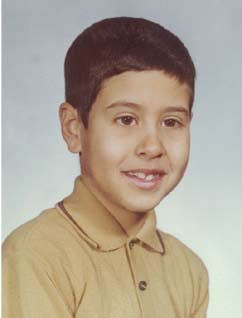 Richie had habits that were unconventional by middle-class American standards. He refused to sit in chairs while eating and preferred to sit on the floor, which his parents forbade. A compromise was settled for: Richie would stand at the dinner table. He got his new clothes washed again and again, until they looked old, before he agreed to wear them. He scraped his new shoes with rocks till they looked worn out. Richie idolized the poor and having better things than others embarrassed him. Once at a country club dinner, he disrupted everything and ran away from the table on discovering that the busboy serving was his classmate.
Richie had habits that were unconventional by middle-class American standards. He refused to sit in chairs while eating and preferred to sit on the floor, which his parents forbade. A compromise was settled for: Richie would stand at the dinner table. He got his new clothes washed again and again, until they looked old, before he agreed to wear them. He scraped his new shoes with rocks till they looked worn out. Richie idolized the poor and having better things than others embarrassed him. Once at a country club dinner, he disrupted everything and ran away from the table on discovering that the busboy serving was his classmate.
A spiritual seeker leads a simple life, by minimizing his or her personal needs, while maximizing his confidence in God. In India, the sadhus, the spiritual mendicants, live in the forest, with mother earth serving as a chair, table, and bed. They wear ragged clothes, and give away their belongings, and subsist on madhuakri, daily meager begging for food. It is a voluntary life of denial of material comforts; not for nothing but for a higher purpose- fixing the mind and energy on service to God. Even as a young child, Radhanath Swami had an inclination for being simple. Radhanath Swami explains that a Sadhu’s primary characteristic is his dependence on God, and of possessing a humble service attitude, fixed in the consciousness that he is the servant of God and all living beings. As little Richie, Radhanath Swami also displayed the characteristic of being conscientious. He ran out of the club so as to not hurt his friend; even as a child Radhanath Swami was sensitive to others’ feelings.
A genuine seeker of God is not impressed by the externals of a spiritual path. He delves deeper into the meanings of rituals and explores the inner secrets of outward worship and prayer. This natural drive to seek deeper meanings once prompted Richie to ask the Jewish rabbi for the meaning of the prayers that he was tutoring Richie in. The Rabbi became emotional; not every seven-year-old begs to know the meaning of prayers offered to God. In India most children learn to pray when they are young, but seldom does a child seek to know the how’s, why’s and what’s of prayer. Richie’s honest inquiry deeply satisfied the Rabbi, and he explained from the Talmud, “It is better to pray to God for the strength to overcome temptations, difficulties and doubts in order to do His will, rather than pray for him to do our will.”
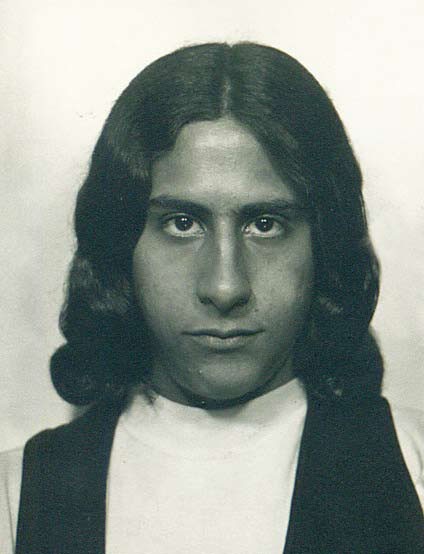 While attending Miami Dade College in Florida, Radhanath Swami, as nineteen-year-old Richard, had the passion for adventure. However, he soon noticed an overwhelming desire taking precedence over everything else in his heart: the desire for spirituality, and an inner quest for subtle realities. He reverentially chanted the sacred syllable Om and practiced Maharshi Mahesh Yogi’s mantra meditation techniques. Thus the seed of spiritual inclination was now slowly growing.
While attending Miami Dade College in Florida, Radhanath Swami, as nineteen-year-old Richard, had the passion for adventure. However, he soon noticed an overwhelming desire taking precedence over everything else in his heart: the desire for spirituality, and an inner quest for subtle realities. He reverentially chanted the sacred syllable Om and practiced Maharshi Mahesh Yogi’s mantra meditation techniques. Thus the seed of spiritual inclination was now slowly growing.
The Vedic teachings extol a human to seek a spiritual goal of life. This quest is a unique endowment of human beings in comparison to animals, who can’t think beyond the four needs of eating, sleeping, mating and defending.
The dormant spiritual spark in all of us needs to be fanned, and we need to go beyond mere bodily needs.
Richard’s long hair and open expression of rebellion towards the norms of establishment attracted hatred from many. However, he felt it an honor to be persecuted for a noble ideal rather than ‘sell-out’ to popular opinions or fashions of the society. Richard and his friends were disappointed with the temporal ambitions of the materialistic society in the 1960s, and preferred to seek a deeper meaning to life.
The Vedic sayings assert that a human who refuses to search for inner meaning of life is no better than an animal. Richard’s desire to rise above mediocrity and live a life centered on a noble ideal is noteworthy. Crass animal pursuits by modern men have caused havoc in modern society. Men, due to their insatiable greed have degraded themselves to lower than animals, for an animal society doesn’t face scarcity of food caused by a member of the same species. Animals also do not face a threat of extinction created by other animals; it’s the humans who create artificial scarcity and threaten to destroy all life on this planet. Animals do not have addictions, insomnia, or suicidal tendencies, a feature unique to a hedonistic human society.
During this time Richard also began to understand that to hate those who hated him was to share the same disease. He took part in a civil rights march in support of Dr Martin Luther King’s vision. His participation in the march was unique because a white boy had shown up for an Afro-American march, but the meeting almost turned violent when the speaker hurled abuses, incited hatred and revenge, and used Richard as a symbol of everything they despised. Richard escaped in time and later reflected on a passage, “If a person does not have an idea he’s ready to die for, he has nothing really meaningful to live for.”
Whether it’s the Afro-Americans v/s the whites, or the hundreds of other ‘us’ v/s ‘them’ issues, cultivating hatred rather than love, while seeking justice, is a sad reality of modern times. Radhanath Swami often appeals that the major hunger problem in this world is the hunger to love and be loved. He is emphatic to declare that if we can tap this power of love within all of us, the world will not only be a better place to live in, but also we can have a higher degree of motivation to serve. His logic is simple; he asks, “Who will take care of a child more-a nurse who’s paid thousand dollars a week, or the mother who isn’t paid anything?” What’s the motivation for the mother vis-a-vis the nurse? It’s love. He tirelessly appeals to the world to tap the power of forgiveness. “If there is to be any peace of mind or harmony in this world, forgiveness is absolutely crucial. If we cannot forgive, then there is no possibility of any relationships surviving at any level”, says Radhanath Swami.
Young Richard’s realizations grew with his spiritual quest, and from knowing that he shouldn’t hate those who hated him, he now shares profound wisdom, “If we understand the underlying cause of what we think of as bad in someone, instead of being hateful, we will be compassionate. For is not every soul inherently good? A saintly person will hate the disease but love the diseased.”
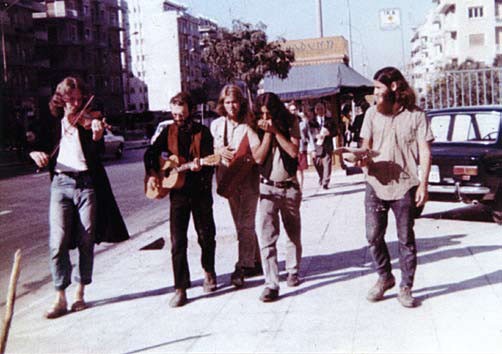 Along with his friends Frank and Gary, Richard decided to go on a trip to Europe. No one from his family had ever ventured out of America. On hearing the news that Richard was planning to leave, Richard’s parents expressed shock and begged him not to leave to a distant land. Their tormented condition and desperate appeals didn’t change Richard’s determination. Richard’s father, in particular, revealed the harsh reality of this world. He implored Richard to change his plan, for this world is a dangerous place and Richard was young and inexperienced. Anything could happen to him. Richard, however, remained firm in his resolve.
Along with his friends Frank and Gary, Richard decided to go on a trip to Europe. No one from his family had ever ventured out of America. On hearing the news that Richard was planning to leave, Richard’s parents expressed shock and begged him not to leave to a distant land. Their tormented condition and desperate appeals didn’t change Richard’s determination. Richard’s father, in particular, revealed the harsh reality of this world. He implored Richard to change his plan, for this world is a dangerous place and Richard was young and inexperienced. Anything could happen to him. Richard, however, remained firm in his resolve.
Richard’s father echoed the sentiments expressed in the religious scriptures of India. The Vedic texts declare this world to be filled with dangers at every step. Radhanath Swami often explains on the basis of the scriptures that if we take shelter of God, the hurdles of this world reduce to the size of a small puddle of water created by the hoof prints of a calf. One not having the Lord’s shelter finds the world and its insurmountable complexities like that of a huge ocean. We are constantly tossed by the waves of this material ocean. The shelter of Lord keeps us sane and happy. This is best exemplified in Radhanath Swami’s own life. His search for spiritual enlightenment led him through one dangerous encounter after another. His close shaves with death are a testimony of God’s hand in his life.
While Richard’s father spoke about the world as a dangerous place, it’s interesting to note that the apparent safe haven like the United States of America is also quite dangerous. For the average traveler, the USA is fairly safe, but the numbers do not lie. There are more than 200 million guns in the USA and more than 50 murders a day, 10 times the rate of Germany. Nearly 5000 people die a year in truck crashes, about 6000 pedestrians die on the streets and 31000 people end their own lives. The USA now leads all nations in violent crime and leads all nations with incarcerations now standing at 2.3 million. American citizens also make up the greatest number of criminals serving time in overseas prisons. The US government is spending a whopping $600 billion a year on defense in order to contain the handful of nations hostile to it.
So are we safe in any corner of the globe? Whether it’s Antarctica with minus 60 degrees Celsius and winds’ tearing in at 100 km/hr, or Brazil, or Bagdad, or Burundi, this world is not only temporary but also miserable. Radhanath Swami appeals that after we end our sojourn in this world we must seek destination in the permanent abode of the supreme Lord. Only that place is free from material inebrieties and fear of death.
During his travels through Europe, Richard marveled at the customs. Coming from the American Midwest, he found the varieties in culture mind-expanding. He contemplated how his whole life he had been conditioned to interpret reality in a certain way, according to the culture he was raised. This, he reflected leads to a parochial outlook towards life. He hoped his search would help him appreciate other human beings and their cultures.
Why was it that we humans seemed to have a deep-rooted proclivity to feel superior to others, particularly in regard to nationality, race, religion, or social position? We think that our condition is normal and others are strange or inferior. This judgmental pride degenerates us into bigotry or sectarianism, generating hatred, fear, exploitation, and even war. I prayed that my travels would open my mind and provide sympathy for how other cultures viewed life, the world, and God. (Excerpt from The Journey Home.)
It is this open-mindedness that softened Richard’s heart and allowed the spark of spiritual craving that had kindled in his heart during his travels, to now become a blazing fire. He was consumed with the desire to know God like a man possessed. It was during this intense phase of prayer and meditation at the mountain top at the Isle of Crete that Richard heard a sweet but commanding voice urging him, “Go to India.” His friend Gary, however, heard a voice that urged him to go to Israel. Bidding a tearful farewell to Gary, Richard took off his black vest and offered as a gift to Gary. The black vest had been an inseparable part of Richard’s identity but now he hoped a journey to India would help him reclaim his eternal identity.
Spiritual life begins with an attempt to rediscover our real identity as part of the divine whole. Radhanath Swami often quotes Jesus Christ who said, “What profiteth a man if he gains the whole world but loses his own soul?” Our basic identity is revealed in the Bhagavad Gita, the Indian classic, as separate from the body. Just as a car is maneuvered by a driver, the body too has a spiritual spark that activates the body with consciousness. When we channelize this energy into serving the divine consciousness, our spiritual horizon expands. This requires us to grow beyond our narrow bodily identifications. We may be proud of being an Indian, American, white, Afro-Americans, rich, or a Christian but our essential identity is we are children of God, a spark of the divine. To the extent, we cling on to our bodily identities to that extent spiritual life remains a mystery.
A life centered on humble service and prayer helps us see ourselves in a new spiritual light. Radhanath Swami compares spiritual growth with an inverse law of gravity. The law of gravity postulates that anything goes up has to come down. Similarly, if we cultivate pride born out of different designations, our attempts at spiritual growth will be curtailed, and we shall come plummeting down. However, if we cultivate the consciousness of servitude and take a low position, we rise in the eyes of God. Lord Jesus said, “Blessed are the poor in spirit for theirs is the kingdom of God. Blessed are the meek for they shall inherit the earth.” A spiritualist bends low in humility and the Lord reciprocates by lifting him high in divine enlightenment.
Richard’s father was absolutely right in declaring this world to be a dangerous place. Radhanath Swami’s travels through Istanbul and Afghanistan on his way to India are scary accounts to read. Afghanistan, in particular, has for hundreds of years, been one of the world’s most strategically important and lusted after territories. However, it remains one of the poorest, undeveloped, and unstable. During the Soviet invasion, the Red Army planted more than 12 million landmines in Afghanistan. Hundreds of people are killed, shredded, and maimed each year due to these insidious devices. Then came the Taliban which meant more banditry, tribal violence, and drug-related violence. No one in Afghanistan is safe, and Richard was traveling alone in this country on his way to India, searching for God.
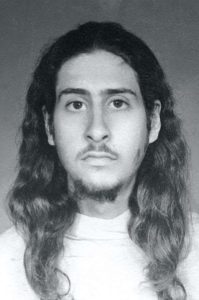 An entire chapter in The Journey Home describes Richard’s struggle at Indian immigration. It had taken him six long months to hitchhike across Europe and the Middle East to reach there. And now, with the denial of entry into the land of his dreams, India, would all of his efforts go in vain?
An entire chapter in The Journey Home describes Richard’s struggle at Indian immigration. It had taken him six long months to hitchhike across Europe and the Middle East to reach there. And now, with the denial of entry into the land of his dreams, India, would all of his efforts go in vain?
Shaken, I walked back some distance along the road behind me and sat in the shade of a large neem tree. As I gazed out across the flat green Punjabi countryside, my mind reeled. Where to go? What to do?
How long I sat there stunned, I do not know. But when awareness of my surroundings broke through again, I knew that I would not turn back. (Excerpt from The Journey Home)
Richard once again meekly approached the tall Sikh officer and pleaded him to allow entrance into the great land of India. Richard cried tears that he had left the comforts of America to search for India’s spiritual treasures and he narrated how he had risked his life. Richard promised that someday he will do something good for the people of India. The Sikh officer relented and stamped his legal entrance into India.
On entering India, Richard found everything excitingly new, yet very familiar. On the very first day, Richard was exposed to a variety of experiences. He saw a multitude of people gathered at the railway station; some cooking, others begging, few lepers and dozens sleeping peacefully amidst the deafening noise all around. He also dangerously dived into a moving train and shared a compartment with two hundred people, in a coach which had the capacity of sixty. He was fed bhang, an intoxicating drink derived from the cannabis plant. Still reeling under its hypnotic effect, a snake charmer put a deadly snake around his chest and demanded fifty rupees. If this wasn’t enough, he ate a red hot chili pepper and his mouth erupted into flames. Richard absorbed every bit of the panoramic scene of India’s capital, Delhi, and found the atmosphere to be a celebration of life.
During his travels through India, Richard saw a yogi in his late thirties beg charity from pilgrims. On being ignored he became angry, and performed miraculous feats to attract attention. He first pulled a live bulb from the socket, and crushed it to powder, and swallowed it by drinking a cup of Ganges water. Then he took a steel rod, and with one end on the wall, he balanced the other end of the metal pole on his eye socket which he had covered with a cloth. Then he slowly walked towards the wall, and the pole bent more and more with each step. Finally, he reached the wall, threw aside the u-shaped rod, and removed the cloth to reveal his undamaged eye. As pilgrims lavished money, the yogi revealed the secrets of his power; his guru had taught him the powers but rejected his student on discovering that he was using it for money and prestige. The yogi now confessed that he needs money to get married, and make a living.
Richard was disappointed and realized that mystic powers are not necessarily spiritual.
Richard arrived at Patna and got the association of Narayan Prasad and his guru Rama Sevaka Swami. Simplicity and devotion poured from the heart of Rama Sevaka Swami in whatever he did. For hours daily he chanted the Holy Names of Lord Rama and he personally fed Richard with his own hands. While staying with him, one day a sadhu, visiting monk, cooked kichari for all. It was unbearably spicy and caused a lot of suffering to Richard while the others were enjoying it. The cook insisted on serving seconds and thirds to Richard and Richard tried blocking his plate but the cook insisted on serving and was very pleased with Richard’s honoring the food. Although Richard was miserable, he didn’t have the heart to tell the cook that he was in pain eating the food. The spice caused tears in Richard’s eyes but the cook thought Richard is crying in gratitude. Richard realized that to please others is not easy but enduring that burning pain was worth it for the sadhu was pleased.
Richard, at Kurukshetra, studied the Bhagavad Gita sitting under the very banyan tree where Krishna originally spoke to Arjuna. Richard had read so many spiritual books but nothing so far had stuck to him as so highly practical. In the world of dangers, temptations, and fear, Richard found immense solace and direction in the immortal words of Lord Krishna. Then and there the Gita became Richard’s handbook. Forty years later, the Gita continues to be Radhanath Swami’s handbook. In many universities and congregation gatherings, Radhanath Swami gives discourses on the Gita, and presents how the teachings of the Gita are beyond historical and sectarian boundaries. Radhanath Swami, however, explains that when studying the Bhagavad Gita we need to have a keen and receptive heart; we should be willing to take in Krishna’s loving message for all of us. We have to be desperate. Radhanath Swami notes that in India it is fashionable to go to spiritual discourses but in most cases, it is pious entertainment and there is no real transformation of the heart. However, the real benefit from the Bhagavad Gita is obtained if we tune in our consciousness to grasp every word of what Krishna was speaking to Arjuna.
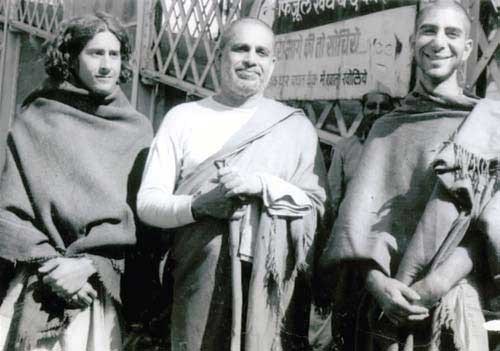
Radhanath Swami ‘accidentally’ lands up at Mathura, on his way to Amarnath. Promising Gary he’d meet him a few days later, Richard then goes alone to Vrindavan. Initially, for a while, while he was at Vrindavan, Richard stayed at Bon Maharaj’s ashram. Everyone there complained about his long, unkempt hair. So Bon Maharaj requested him to shave his head like the other ashramites. Richard pleaded that for him shaving the head meant surrendering to a mentor, and therefore until he feels strongly about surrendering to a guru, he wouldn’t shave. Then Maharaj suggested that he at least cut it shorter as now the hair hung halfway to his waist, and his mane was quite matted. Richard agreed but the hair was so thick that no scissor could penetrate the hair. Finally, they called for a gardener who bought loppers used for cutting bushes. The four men- gardener, barber, and their two assistants- strained and groaned as they pushed the cutter from both directions. Finally, after the great struggle, the two blades of the bush cutter snapped together and the project was complete. Asim, Richard’s newly found friend in Vrindavan, laughed all the while so hard that tears streamed down his cheeks.
Finally, at Vrindavan, in the Samadhi, the tomb of a renowned saint named Rupa Goswami, Richard (now Radhanath Swami) underwent an experience that revealed to him that Bhakti-yoga was his path. As he knelt before Rupa Goswami’s tomb and prayed silently, he experienced invisible energy filling his body and mind. Suddenly, Richard knew, with certainty, that bhakti was the path he would give his life to and that Krishna’s name would, in time, reveal His love to him. All reservations that had earlier prevented him from committing his whole heart to the path of devotion were now gone. Still, emptiness lingered within him for he knew he had to accept a guru to whom he could fully dedicate himself fully. To harmonize one’s life in the service of a guru’s teaching was the path that enlightened souls had followed since time immemorial. Richard intensely prayed for direction.
In the association of the saint Ramesh Baba, at the remote mountains of Varsana, thirty kilometers from Vrindavan, Richard learned about the power of faith in God. A young boy of seven caught Richard’s hand and pointed to a painting of Krishna and declared with simple innocence and faith, “This is my God.” Seeing this Richard remembered Lord Jesus’ words that unless one becomes like a child in his purity and faith, he cannot enter into the kingdom of God. Richard prayed to be blessed with such faith.
Ramesh Baba was constantly threatened by thugs, wielding guns and knives. Yet he remained undisturbed having taken shelter of God’s names in kirtan. With the power of kirtan, he carried a conviction that if Krishna is pleased with him, it didn’t matter what the dacoits did. This unbelievable faith of Ramesh Baba was once again witnessed by Radhanath Swami when at night, Ramesh Baba slept with a small three-foot stick by his side, to protect himself from a leopard. When Richard asked how a little stick would help, Ramesh Baba replied that only the Lord can protect them. However, he kept the stick to show the Lord that he is doing his part. Ramesh Baba taught that chanting the Holy names of God is our only protection and we should cultivate faith in these names of God.
While in Varsana, Richard learned through personal experience, the lesson on the need to have faith in the holy names. Once while responding to the call of nature in the fields, a poisonous snake crept up to his feet as he squatted on the floor. As his heart pounded in fear, he softly chanted Hare Krishna Maha Mantra. He gradually began to feel peace through the power of the mantra, and his fear dissipated. As the serpent slowly slithered back into the bushes, Radhanath Swami reflected: “Today the Lord has revealed to me what a tiny child I am on the spiritual path. When a child is in danger, his only means of protection is in appealing to his mother or father. And today the mother and father of this tiny child have come in the form of their holy names to give me shelter.”
Radhanath Swami’s adventures have given him profound realizations on the subject of faith. He shares his realization that when everything seems to go wrong in life, faith alone can empower us to look up to see the benevolent hand of God guiding us out of our problems, to understand that everything is actually alright even if it appears wrong. Radhanath Swami’s formula for happiness is also simple; when we are faced with adversities, as is inevitable in this world, our peace and happiness will depend not on our wealth, but our faith. It’s also important to nourish and protect this faith in God. Radhanath Swami gives the example of a tree that takes years to grow. However, it takes a few hours to bring it down crumbling. Similarly, it takes years of spiritual practices to cultivate faith but a complacent and lax approach to spiritual practices will allow the illusory forces to drag our innocent faith down, in a matter of moments. He warns, “To lose money, prestige, health or even life itself is not such a loss. To lose faith is the greatest loss.” How can we increase our faith in God? Radhanath Swami offers a time tested method of hearing the message of the Lord as revealed in the sacred scriptures from His dedicated devotees, and by regularly chanting His Holy Names.
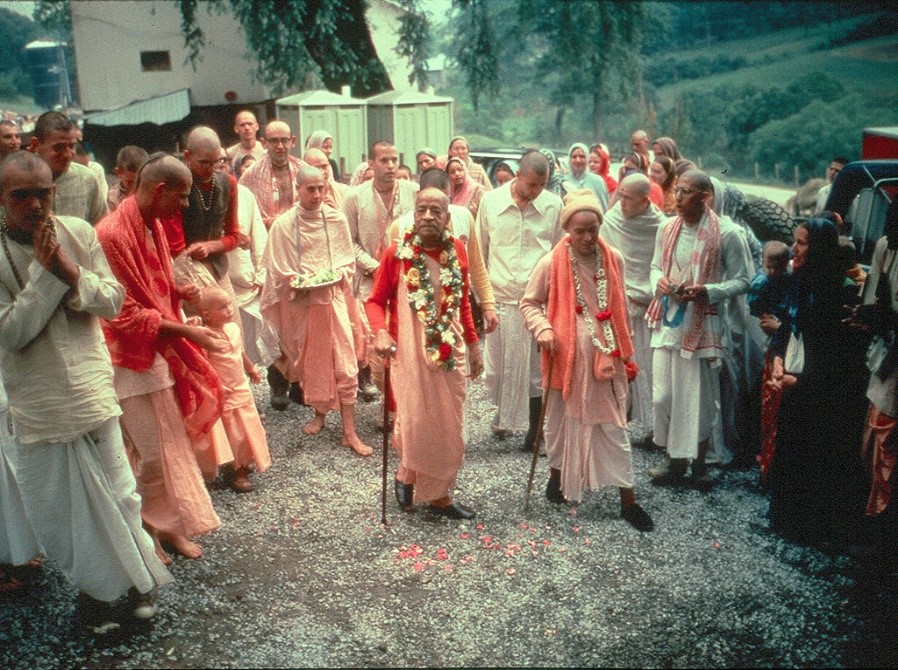
While at Vrindavan, Richard met Srila Prabhupada, the Founder-Acharya of ISKCON who was visiting there with his western disciples. Richard was sometimes rebuked by Srila Prabhupada’s leading disciples. They pressured him to make a commitment and urged him to join the movement and travel with them. He didn’t like such pressurizing, although he was used to it. Radhanath Swami writes that he thought he would surrender to a guru only if he was impelled by deep faith and inspiration, and not by somebody’s pressure. One afternoon Srila Prabhupada asked how long had he been staying in Vrindavan. Richard thought he too would chastise him for living in Vrindavan. Richard replied, “About six months Srila Prabhupada.” After a minute-long pause and gazing into his eyes, Srila Prabhupada replied, rubbing Richard’s head affectionately, “Very good, Vrindavan is such a wonderful place.”
In this briefest of exchanges, Richard experienced the love of an eternal friend, a benevolent parent, and of God. This had a profound impact on him which he could neither understand nor explain:
Radhanath Swami describes he closed his eyes and pondered: “He is such a busy man, with tens of thousands of people the world over waiting for a moment of his time. Why did he stop for me? I have nothing to offer, I am just a penniless nobody who sleeps under a tree” “Perhaps”, Radhanath Swami thought, “the miracle of being an instrument of kindness is the most powerful of all.”
While at Vrindavan, Richard decided to surrender to Srila Prabhupada and accept him as his guru. He finally took initiation from Prabhupada in the United States in February 1973 and received the name ‘Radhanath Das’.
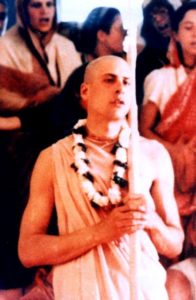 In early 1982, ISKCON leadership offered Radhanath Das to take sannyasa (the way of life of renunciation). Though hesitant at first, arguing that the honor and respect that is traditionally conferred upon sannyasis will interfere with his spiritual life, Radhanath eventually agreed after persuasion. The sannyasa initiation ceremony of Radhanath Das was held in May 1982 in the United States. On accepting the vows of lifelong renunciation, Radhanath received the title of “swami”, and since then is known as “Radhanath Swami”.
In early 1982, ISKCON leadership offered Radhanath Das to take sannyasa (the way of life of renunciation). Though hesitant at first, arguing that the honor and respect that is traditionally conferred upon sannyasis will interfere with his spiritual life, Radhanath eventually agreed after persuasion. The sannyasa initiation ceremony of Radhanath Das was held in May 1982 in the United States. On accepting the vows of lifelong renunciation, Radhanath received the title of “swami”, and since then is known as “Radhanath Swami”.

In 1988 Radhanath Swami came to India and headed the project in Mumbai. He established the Radhagopinath Temple, an ashram, and a spiritual community. The way Radhanath Swami built his community of dedicated members at Mumbai is a classic example of his tolerance. The community premises where Radhanath Swami lived in the late 1980s was poverty-stricken. The neighborhood was noisy; he had rats- the size even cats would fear- for company. Even by Indian standards, the place was disgustingly dirty; yet Radhanath Swami- an American by birth- lived here happily chanting the names of God and influencing others through his sterling qualities of tolerance and patience. Radhanath Swami is constantly absorbed in selfless service; hence he easily transcends physical surroundings.
Recently at a program of guests and friends from Mumbai who have known Radhanath Swami for over thirty years, heartfelt appreciation was showered on him. He too spoke for over two hours, recalling in great detail, the kind acts of all the members present, over the last three decades. He remembered which friend had cooked for him rice, chapattis, and idlis (a special Indian cuisine) in 1988, and who had offered help in 1991. Many of the past exchanges, recollected with great happiness, seemed insignificant to my mundane intelligence. A couple of days later, I personally expressed to him my wonder at his extraordinary memory, and his emphasizing on minute details of human interactions. His answer humbled me. With deep gravity, he replied, “If I do not remember the services of all these great souls, the men and women who have done so much for this community in Mumbai, and the related projects, my life is verily condemned.” I now knew for sure, he meant each letter of the appreciation and gratitude he expressed towards all community members.
On another occasion, in a monthly festival lecture for over a thousand youth, a man got up and spoke on the merits of good health, and he warned all the assembled youth to avoid sin. A discussion then ensued on what the greatest sin is. Radhanath Swami expressed his understanding of the greatest sin, “To be ungrateful for all the wonderful gifts bestowed upon us by God, parents, friends and Mother Nature, is the greatest sin.”

Radhanath Swami’s best friend Bhakti Tirtha Swami on whose insistence Radhanath Swami wrote ‘Journey Home’ described God’s grace beautifully. Bhakti Tirtha Swami went through external sufferings in the form of cancer and amputations etc., especially during the last phase of his life. But he accepted these difficulties with grace and dignity, teaching all of us how to accept sufferings in this world. With heartfelt gratitude to God for his sufferings, he composed the following:
“I asked for strength, and God gave me difficulties to make me strong
I asked for wisdom, and God gave me problems to solve….
I prayed for favors, and God gave me opportunities”
I asked God to grant me patience, and God said:
“No, suffering draws you apart from worldly cares and brings you closer to Me.”
I received nothing I wanted
I received everything I needed.”
Radhanath Swami says that such heart-felt sentiments open our eyes to the understanding of why are sufferings and tests necessary: they help us to grow deep and take full shelter of God.
Bhakti Tirtha Swami also once attempted to enter the famous Jagganath temple in Puri, India. In 2005 Radhanath Swami described this exciting story in a marathon six-hour class on the glorious services of Bhakti Tirtha Swami.
Radhanath Swami narrated that in 1978, Bhakti Tirtha Swami was in India. At that time in history, not a single foreigner had ever been inside Jagannath’s temple in Puri, in the state of Orissa. Bhakti Tirtha Swami had been once told by his guru that in this lifetime he would see God. So he thought, “Maybe I will see God as Lord Jagannath in this temple.” He had a black complexion and thought perhaps the ever-vigilant temple priests at Puri may think he is from South India and they would allow him in. He tied a towel around his head to look Indian. There were big crowds, and he walked right by the gatekeeper. He went deeper and there was a massive crowd, thousands of people near the main altar of God. At that time, Bhakti Tirtha Swami thought, “If they catch me now they are going to really beat me, I don’t know what will happen.” All of a sudden, the pandas, the official doorkeepers in the temple stopped the crowd and began choosing people that they thought had money and called them forward. One of them called Bhakti Tirtha Swami Maharaj forward, “You come.” He spoke in Oriya language, and Bhakti Tirtha Swami was afraid because if the panda spoke to him, he would be caught because he only spoke English. The person started asking questions. Bhakti Tirtha Swami couldn’t understand a word. He just remained silent and was praying to the Lord. The person brought him right up to the altar and pushed his head right on the altar, and let him stand there to offer his prayers of love. He then took him to circumambulate the temple, and meanwhile, so many other pandas tried to get money from him but this one panda was saying, “He is mine, he is mine.”
After he had this amazing experience, the panda who was actually the chief priest of the temple called him out and spoke to him in English, “I know who you are. I don’t agree that you people shouldn’t be allowed in the temple, so I have arranged this audience for you with the Lord.” Bhakti Tirtha Swami was so overwhelmed with this divine spiritual experience that the next day he thought he would do it again. However, this time the pandas discovered he was not an Indian, and they started screaming at him and chasing him and Bhakti Tirtha Swami ran. He narrowly escaped and realized we should be satisfied by what God has given us.
Radhanath Swami says that Bhakti Tirtha Swami was the first foreigner to have ever personally got the audience of the Lord at Jagganath Puri. His guru’s prophecy had indeed come true “You will see God in this lifetime.”
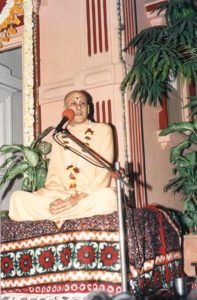 Hearing Radhanath Swami’s talks I get a feeling that Krishna as a God is a mesmerizing blend of greatness and sweetness. All religions declare that God is great and Radhanath Swami speaks from the eleventh chapter of Bhagavad Gita and explains how this greatness can be seen even in Krishna. However, there is another aspect to Krishna, says Radhanath Swami, and that is the sweetness of his attraction and love. I once heard Radhanath Swami describe Krishna’s stealing of butter from the house of the women in Vrindavan. A thought came across my mind, “Why should God steal and perform mischief?” As if answering my doubt, Radhanath Swami explained, “Krishna as God is self-satisfied as everything belongs to Him. However, he likes to reciprocate with the love of His devotees, for Krishna is bound by that love.”
Hearing Radhanath Swami’s talks I get a feeling that Krishna as a God is a mesmerizing blend of greatness and sweetness. All religions declare that God is great and Radhanath Swami speaks from the eleventh chapter of Bhagavad Gita and explains how this greatness can be seen even in Krishna. However, there is another aspect to Krishna, says Radhanath Swami, and that is the sweetness of his attraction and love. I once heard Radhanath Swami describe Krishna’s stealing of butter from the house of the women in Vrindavan. A thought came across my mind, “Why should God steal and perform mischief?” As if answering my doubt, Radhanath Swami explained, “Krishna as God is self-satisfied as everything belongs to Him. However, he likes to reciprocate with the love of His devotees, for Krishna is bound by that love.”
In India, Krishna festivals are very popular with millions congregating to hear week-long discourses on Krishna’s activities, especially about his childhood play and frolic in Vrindavan. These discourses are given by popular professional speakers, with accompanying kirtan, musical performances. Reading about Krishna fills the hearts of his devotees with incalculable sweetness. Interestingly I have observed Radhanath Swami and many other speakers repeat the stories about Lord Krishna with much excitement and enthusiasm as if they were narrating it for the first time. I understand that repeated speaking and hearing these stories simply increases the joy of the devotees.
Krishna theology is refreshingly different from the stereotyped understanding of God as a great Lord who metes out justice and awards the faithful on the Day of Judgment. Krishna is the same God as understood in all other theistic traditions, but the sweetness aspect of His personality helps devotees relish the path of Bhakti yoga.
The German philosopher Friedrich Nietzche said, “I would believe in a God who could dance.” Krishna is known as an expert dancer, natabara, who dances in rasa lila, the dance of divine love, in the pastures of Vrindavan. Radhanath Swami explains that we can also experience the sweetness of God by sincerely chanting the Holy names of God. The Holy names are also great and sweet, says Radhanath Swami. They are great because they can destroy the negativities from the heart and at the same time the sweetness of the Holy names can also be experienced by spiritualists who chant with great feeling of love.
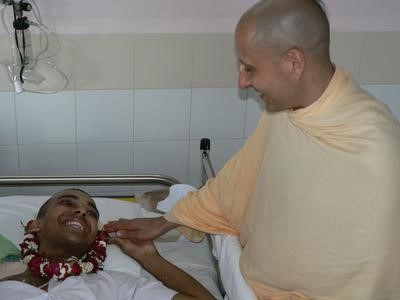 When one of Radhanath Swami’s young students, Stoka Krishna was dying of cancer, he was next to him and repeatedly spoke about God’s kindness upon all of us. Radhanath Swami lovingly encouraged the young man to remember God and seek hope in God rather than material facilities. Sitting at his bedside, Radhanath Swami described in detail the spiritual world to young Stoka Krishna. Stoka Krishna was smiling and grateful to the Lord and devotees as he left his body. His departure is not only a glorious example of facing death but the incident filled the lives of all of Radhanath Swami’s followers with hope in the mercy of the divine.
When one of Radhanath Swami’s young students, Stoka Krishna was dying of cancer, he was next to him and repeatedly spoke about God’s kindness upon all of us. Radhanath Swami lovingly encouraged the young man to remember God and seek hope in God rather than material facilities. Sitting at his bedside, Radhanath Swami described in detail the spiritual world to young Stoka Krishna. Stoka Krishna was smiling and grateful to the Lord and devotees as he left his body. His departure is not only a glorious example of facing death but the incident filled the lives of all of Radhanath Swami’s followers with hope in the mercy of the divine.
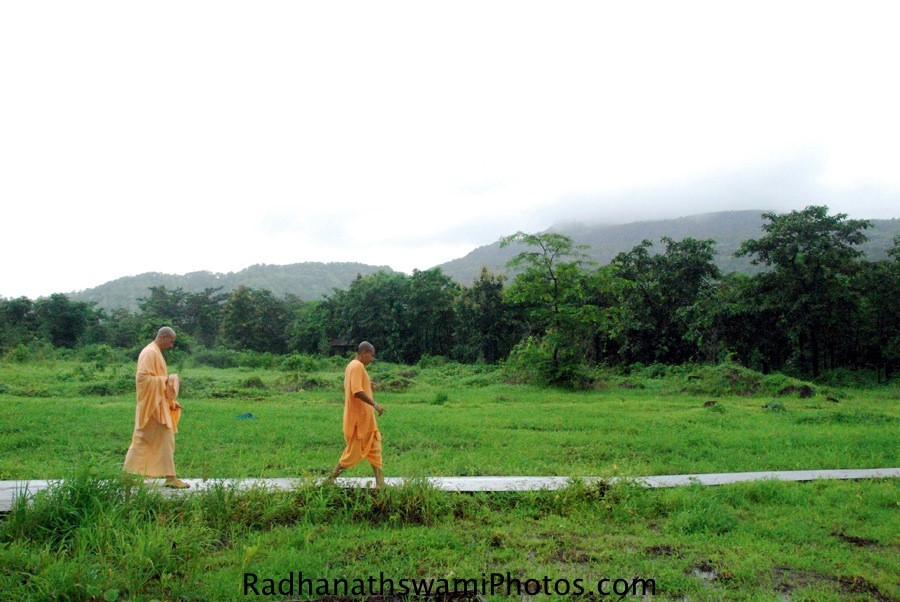 Under the inspiration and guidance of Radhanath Swami a dedicated community began the development of the Govardhan Ecovillage in 2003 with the aim of demonstrating the principles of self-sufficiency and localized economy and highlighting the importance of living in harmony with nature by presenting a sustainable living model. Gradually they developed fundamental aspects of the eco-village including organic farming, cow protection, education, rural development, alternative energy, eco-friendly constructions and sustainable living. The Ecovillage, which is located near the Sahyadri mountain range, a two-hour drive from the city of Mumbai, was inaugurated on 24th December 2011.
Under the inspiration and guidance of Radhanath Swami a dedicated community began the development of the Govardhan Ecovillage in 2003 with the aim of demonstrating the principles of self-sufficiency and localized economy and highlighting the importance of living in harmony with nature by presenting a sustainable living model. Gradually they developed fundamental aspects of the eco-village including organic farming, cow protection, education, rural development, alternative energy, eco-friendly constructions and sustainable living. The Ecovillage, which is located near the Sahyadri mountain range, a two-hour drive from the city of Mumbai, was inaugurated on 24th December 2011.
The inauguration marked the opening of the eco-village as a retreat center with green design cottages, auditorium, seminar and conference rooms, an Ayurvedic wellness center, and a yoga center.
Radhanath Swami shares his vision and dream behind the creation of Govardhan Eco-village: “Simple living, high thinking is the principle that is the basis of this rural community. Though we all have individual mothers, Mother Earth is the mother of all life on the planet. Thus Mother Earth is common to all of us and we are heavily dependent on her. Living in harmony with Mother Earth is a big responsibility. This is the most important sacred principle we must remember.”
The Govardhan Eco-village has been built for the modern lifestyle needs of both individuals and corporate groups. It hopes to serve as a model of how spirituality can integrate the needs of a modern society with traditional answers. Radhanath Swami says, “In the quest for technology we keep taking from mother earth, but as we grow we should reciprocate.”
The structures of the eco-village are made of natural materials such as cob, rammed earth, and Compressed Stabilized Earth Blocks which are made by compressing a combination of earthen materials with added stabilizers without the use of furnaces to heat the bricks. The natural property of earth changes when it is heated. The use of raw mud for building houses has many advantages – its local availability and ease of processing makes it the most energy-efficient building material. Houses made of earth give warmth in cold atmospheres and provide a cooling effect in hotter climates.
Some other ways the eco-village strives to live in harmony with Mother Earth:.
- In consultation with organic farming experts, all inputs and outputs are natural
- Only indigenous varieties of grain are grown
- Instead of chemical fertilizers, cow dung and natural compost are employed
- Cow urine and neem oil serve as organic pesticides
- Bulls are favored over machinery for plowing
- Solid waste management and wastewater treatment center minimize its carbon footprint
- For alternative energy, a bio-gas plant has been established to generate electricity for uses such as water pumping and irrigation
- Solar energy provides energy for street lights and water heaters
- Cottage industry manufactures various cow-based products
- 20 different types of vegetables, 10 varies of fruit, 9 varieties of flowers and 4 kinds of grains are grown on the farm
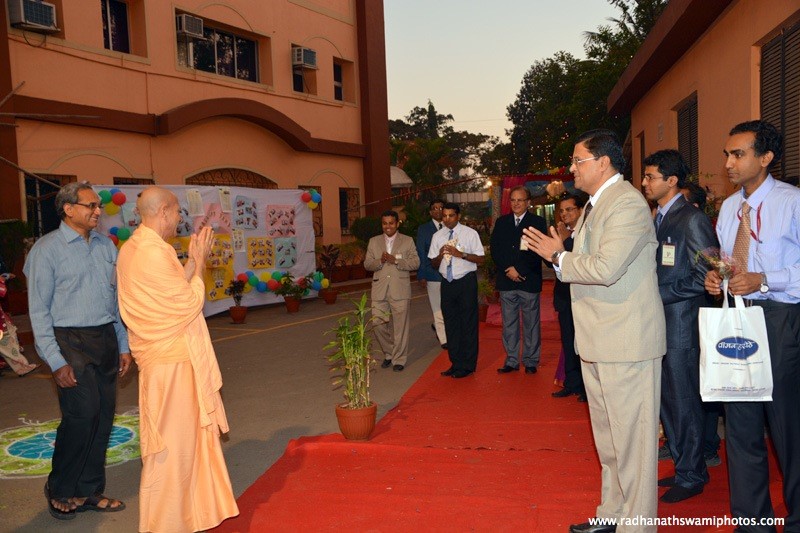 “It is truly an honor to be here this evening,” says spiritual leader Radhanath Swami, his voice echoing out over the Mumbai crowd. “Twenty years ago today, we came together to inaugurate Bhaktivedanta Hospital, not knowing where this journey would lead us.”
“It is truly an honor to be here this evening,” says spiritual leader Radhanath Swami, his voice echoing out over the Mumbai crowd. “Twenty years ago today, we came together to inaugurate Bhaktivedanta Hospital, not knowing where this journey would lead us.”
That answer is self-evident now, during the 20th-anniversary celebrations of the unique hospital inspired by Srila Prabhupada’s teachings. Held on January 11th 2018, the celebrations drew a massive attendance of three thousand hospital staff, doctors, managers and their families. And the celebrations were held on the land where a major extension is set to be built.
But back in 1991, Bhaktivedanta Hospital was just a dream in the hearts of five young medical graduates, who had become devotees while in medical college – Madhavananda Das, Visvarupa Das, Giriraj Das, Dwarkadish Das, and Vaishnavananda Das. The group wanted to provide holistic care with a Krishna conscious ethos to as many people as possible.
They began by taking medical camps to various areas in and around Maharashtra, serving underprivileged people who had no access to modern medical care. Eventually they started the tiny seven-bed “Bhaktivedanta Clinic” on Mira Road, a distant suburb of Thane, near Mumbai.
Today, that clinic has grown into a state-of-the-art 210-bed hospital with 1,000 devotee staff. The hospital has six modern operation theaters, with a full-fledged heart center for angiography, angioplasty, and open-heart surgeries. The hospital sees around 250,000 outpatients per year and admits some 20,000 inpatients both from India and abroad.
As if that isn’t enough, Bhaktivedanta Hospital has twelve satellite centers – most of them in Maharashtra, with a full hospice in Lord Krishna’s hometown of Vrindavana, and an eye hospital in Srimati Radharani’s birthplace Varshana.
The hospitals are holistic in two ways. While they predominantly practice allopathy, they provide alternative therapies for patients such as homeopathy, Ayurveda, naturopathy, yoga therapy and acupuncture too. They are also holistic in the sense that they care for the patient’s body, mind, and soul.
Spiritual care, the most unique element of Bhaktivedanta Hospital, plays a large part in this. “In other hospitals, spiritual care is generally restricted to those who are terminally ill,” says Director Madhavananda Das. “But in ours, practically every patient will get spiritual care in some form.”
At Bhaktivedanta Hospital, each patient is allocated a spiritual care counselor, who develops a friendship with them so that they have someone to talk to for both spiritual and emotional support whenever they need. Like doctor assessment forms in other hospitals, spiritual assessment forms are filled out every day at Bhaktivedanta Hospital.
Every evening, a small ratha, or cart, carrying Deities of Jagannath, Baladeva and Subhadra visits each patient’s bedside. The patient then gets to offer Them flowers and incense, or a ghee lamp during the Kartik month, and also receives Their prasad.
In addition, an atmosphere of “sattva guna,” or “the mode of goodness,” is created in the hospital through cleanliness, Krishna conscious pictures everywhere, the smell of incense and kirtan piped through speakers 24 hours a day.
This, Madhavananda says, creates a sense of comfort and trust, and often sees patients recover at Bhaktivedanta Hospital when their condition was not improving elsewhere. Many ISKCON devotees and others travel long distances across the world to be treated at Bhaktivedanta Hospital for this reason.
Critical patients, meanwhile are brought into the hospital’s own Jagannath temple room, where staff pray, do kirtan or read the Bhagavad-gita with them. With terminal patients, medical staff read and chant the Holy Names for them, encourage their relatives to carry out “six loving exchanges,” and at the last moment give them Ganga water and Tulasi leaves.
For patients of different faiths, chaplains from their own tradition are brought in to read the Bible or Koran and conduct other appropriate care.
“Often, however, our experience is that a dying man doesn’t have any religion,” says Madhavananda. “So they want every possible good thing, and will ask to hear the Gita as well as their religious text, and kirtan as well as their prayers.”
Bhaktivedanta Hospital takes its approach very seriously, and has built a whole research department around spiritual care, with research papers regularly published in international journals.
Interestingly, it’s not only the patients that get spiritual care at Bhaktivedanta Hospital. The staff also gather daily for prayers, and once a week in the temple room for a spiritual program.
Outreach is a major concern, too. Patients who have been discharged are invited back for medical and spiritual seminars, while free clinics are held for tribals and poor people within a 100-kilometer radius.
Perhaps most notable is the famous eye camp held in Varshana once a year during January/February. Doctors from Bhaktivedanta Hospital and volunteers from other medical establishments provide cataract surgery and medicine for free to around 1,000 underprivileged Brijabasis every year. There’s also a 10-day dental camp for dentures, tooth extractions, and more. And the full-time satellite center in Varshana provides all-round medical care throughout the year, free of cost to ninety percent of patients. Altogether, nearly 5,000 Brijabasis receive free care from Bhaktivedanta Hospital every year.
So what now, after twenty years of care for the body, mind, and soul? Well, Bhaktivedanta Hospital will soon open an expansion at its main Mira Road location, which will have 100 more beds and be equipped to the latest medical standards.
The hospital will also soon receive postgraduate medical college status, meaning that hundreds of new doctors will be trained in the Bhaktivedanta Hospital spiritual ethos.
Those who decide to take up employment at Bhaktivedanta Hospital, Madhavananda promises, will experience deep fulfillment of both their material and spiritual aspirations.
“It’s wonderful to work here,” he says. “We may go through the same ordeals and issues that any other job has. But that is all mitigated because you are working in a perfect spiritual atmosphere, with Srila Prabhupada at the center, and Jagannath, Baladeva and Subhadra worshipped in Their own temple in the hospital every day.”
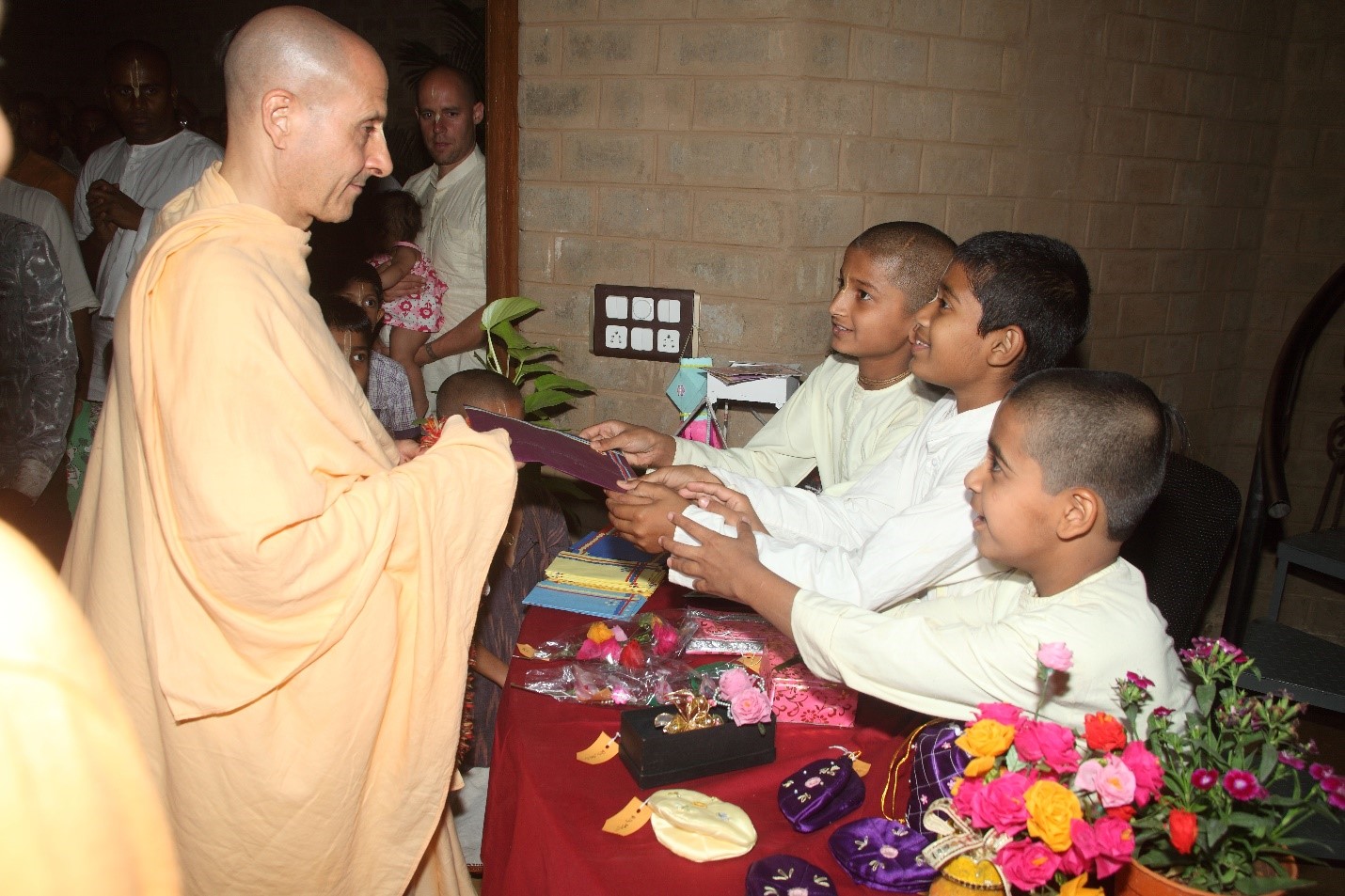
Under Radhanath Swami’s leadership, an orphanage of fifty children is flourishing at the outskirts of Mumbai. All the needs of the children- physical, emotional and spiritual- are cared for by a team of full time dedicated and trained teachers, managerially supervised by a trust consisting of respectable members of the society. Living in a rural setting, close to nature, the children learn practical skills that would help them earn a livelihood later. They also learn the ancient literature and the moral lessons taught in them. To help assimilate the spiritual principles deeply, the children perform regular dramas at the nearby villages, for the spiritual edutainment of thousands of villagers. Once I wondered why the children are staying at a village hundred kilometers from the city when the happening place is the city of Mumbai, and that’s where we have the temple, and the two thousand plus flourishing community. I then recalled that Radhanath Swami’s parents had also done something similar in 1955. When Richie was four, they moved from Chicago to the tranquil village of Sherwood Forest. They did this so that they could raise Richie and his two brothers in an environment free from the pollution and dangers of the big city. Yes, the children in this rural setting are also learning the virtues of pursuing a pure and noble life, centered on service to God and society. Of course, there are also examples of parents who have successfully trained their children in cities, and implanted a spiritual culture in them.

The Indian Government’s Midday Meal Scheme, which began in 1995 to help poor children at all public schools, approached ISKCON Chowpatty in Mumbai in 2004 to be one of the NGOs implementing the program.
Annamrita, the school meal program was initiated by the inspiration of Radhanath Swami. On the first day, 900 children were fed.
Over the past 15 years, Annamrita, driven by the vision to create a world in which no one in need goes hungry, has transformed lives of more than 10 Lakh children in over 6,500 schools across the country.
“Annamrita” means “food as pure as nectar.” Poverty and hunger in India are epidemic, with a majority of the population unable to get even one nutritious meal a day. The major factor behind this social calamity is a vicious circle of poverty and illiteracy that has gripped India for decades.
Annamrita has resolved to liberate the underprivileged from this vicious cycle by serving children with the purist plant-based meals. The meals are not only strictly plant-based but are also imbued with the spiritual ambiance of annamrita’s hi-tech, super hygienic kitchen. They believe such pure food will nourish the mind, body, and soul.
The hot meal is prepared with the highest standards of hygiene and quality ingredients that meet the nutritional requirements of growing children. But most importantly, Annamrita mixes a secret ingredient to the vegetable stew (kichdi) it serves – love, devotion, and compassion that adds an unparalleled taste of purity to the meal.
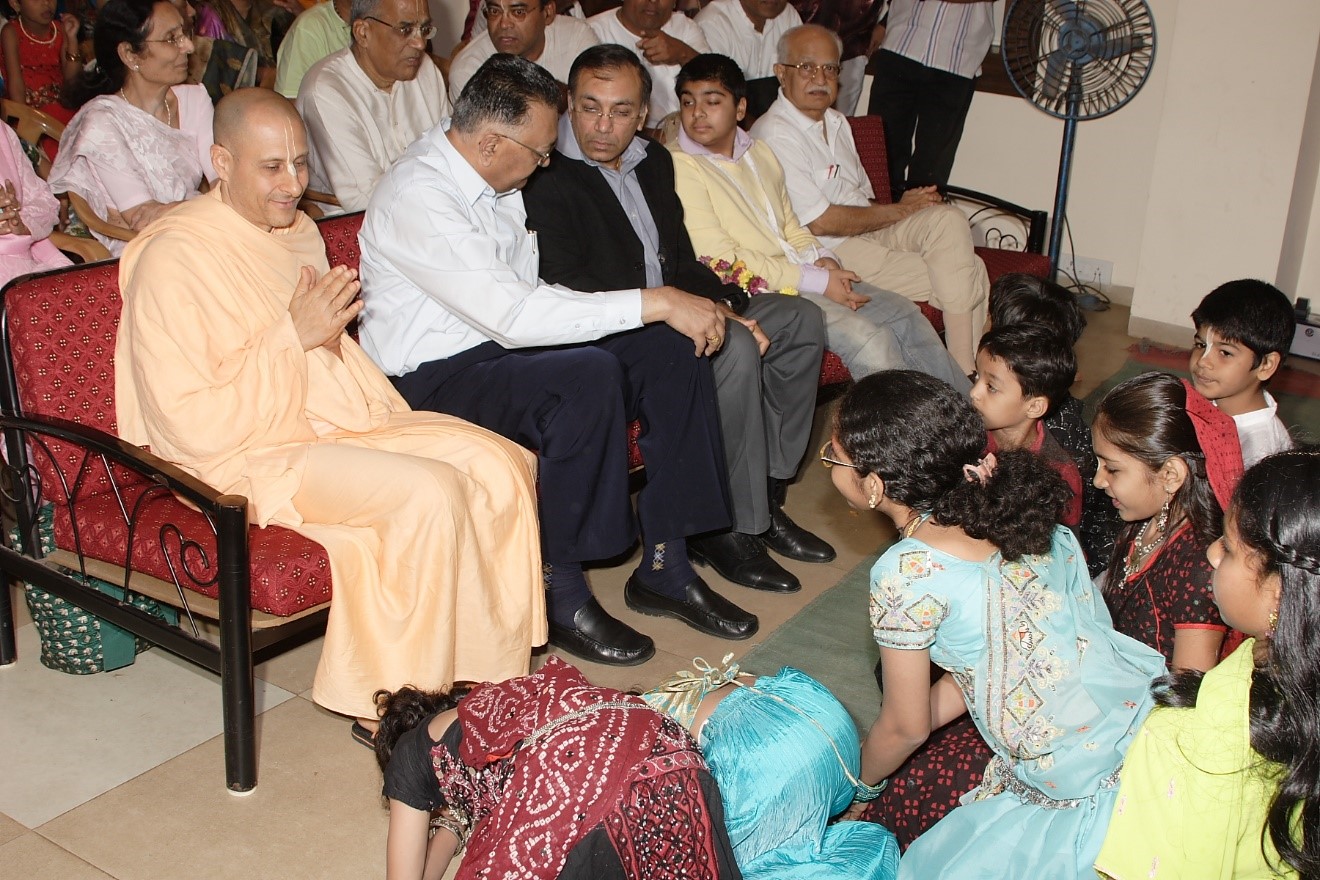
Gopal’s Fun School (GFS) is a weekend program for urban kids started at ISKCON Chowpatty under the inspiration of Radhanath Swami.
Every parent has an earnest desire to give their child the best by fulfilling their physical, emotional, social and spiritual needs. GFS recognizes the importance of these priorities and equips children with life long skills, which will enable them to make positive and outstanding contributions in all aspects of life as well as meaningful contributions to society.
Through a lively blend of art, stories, quiz’s, dramas, games, puppet shows and multimedia exploits a child is exposed to spiritual culture and wisdom. The sessions include spiritual prayers, meditation, and yoga.
GFS imparts holistic education to children in the development of their character and personality. Workshops encourage the development of basic values and talents. A simple gesture of offering flowers to the altar cultivates the value of giving and not withholding. It evolves into a spirit of compassion and sharing, and selfless concern for others.
Modern society has discovered that, beyond physical needs, human beings also have emotional and spiritual needs. Parents today are baffled and pained to see their children succumb to stress, depression, addiction, violence, delinquent behavior and even suicide. Moreover, they often have little respect for their parents and elders, and do not abide by traditional moral and spiritual values as meanings have been diluted over the years. Studies confirm that a child bereft of spiritual training easily falls prey to bad habits. A spiritually guided child, on the other hand, is well equipped to counter harmful influences and confidently face the stresses and tensions of modern life. Knowing why things are done is also beneficial to the child and enables them to transfer their inquisitive and knowledgeable nature to all aspects of their life’s.
The concept of the fun school at ISKCON Chowpatty is about 8 years strong. As part of this program, children of various age groups are trained expertly in the spiritual field with a view to awakening God-consciousness in them so that over a period of time they become divine law-abiding citizens and consciously make the correct decisions in life to keep away from everything any caring parent would want them to avoid.
As part of the program, students are taught various aspects of the Bhagavat Gita, outdoor games based on Krishna Consciousness, kirtans/instruments, and bhajans/traditional Indian folk music. Above all, they are provided with a sense of responsibility towards themselves and society as a whole. With an enrolment of around 350 children between age groups of 3-5, 6-8 ,10-15 ,15-21, the school continues to grow with many parents articulating their satisfaction and appreciation of the institution and the positive impact it has had on their children. There are currently 2 schools in Thane and a couple of them in South Mumbai.
GFS adopts state-of-the-art techniques to make learning a joy. Teaching is done through a lively blend of art, craft and drawing, quizzes, assignments, worksheets, dramas and puppet shows, spiritual games and picnics, and color slide/ video shows. Bal-utsav (Festivals for children) provides the children with an opportunity to display their talents.
Modern society has started discovering that human beings have not just physical needs, but also emotional and spiritual needs. In Western countries, parents have provided abundantly for the material needs of their children. Yet despite their best efforts, most parents are baffled and pained to see their children succumb to stress, depression, addiction, violence, delinquent behavior, and even suicide. Even if the children survive such unfortunate influences, when they grow up, often they have little respect for their parents and elders and then they disregard ethical, moral, and spiritual values that their parents cherish. Numerous surveys have confirmed that a child without a spiritual basis to his life easily falls prey to bad habits. A spiritually trained and guided child on the other hand, is well equipped to counter harmful influences and confidently manage the stress and tensions of modern life. Therefore, GFS aims to help responsible parents in raising their children by offering systematic and scientific training in spiritual culture and wisdom.
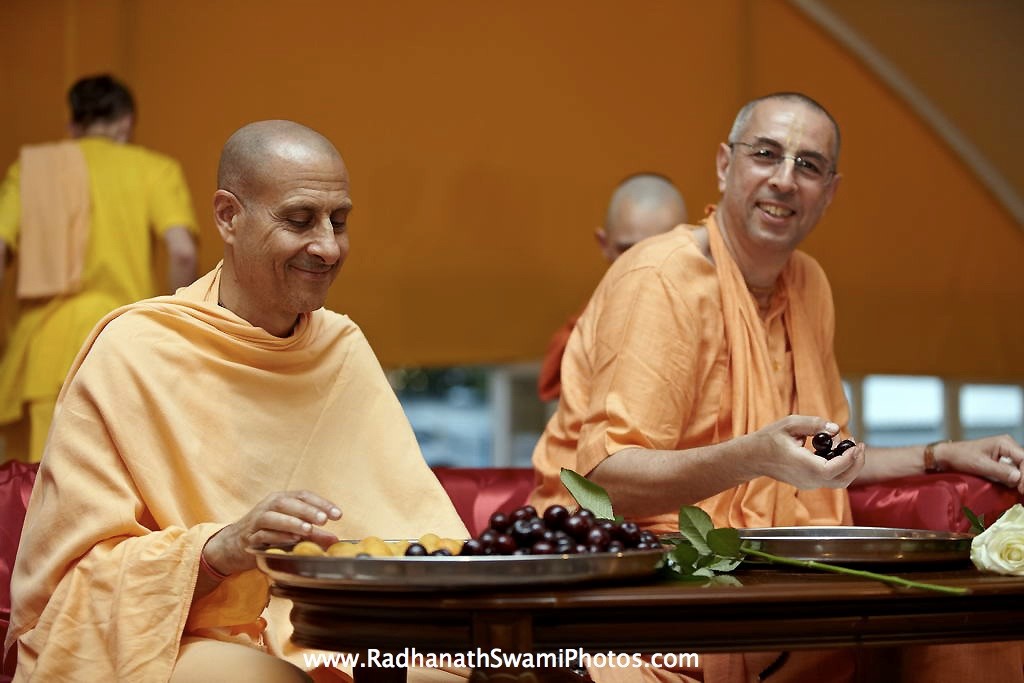
During my travels in India, I once met Niranjan Swami, an old time friend of Radhanath Swami. Niranjan swami described to me his friendship with Radhanath Swami. “The last night I had a special dream”, confessed Niranjan Swami. “I dreamt that I am in deep sleep, and Radhanath Swami is sitting next to me and lovingly pouring sweet rice, (a special Indian sweet) into my mouth. As he was feeding me spoon by spoon, he was lovingly calling out, ‘Oh, my dear Niranjan Swami, please wake up.’ This is the only dream I had the whole night. I am eagerly waiting to meet him.”
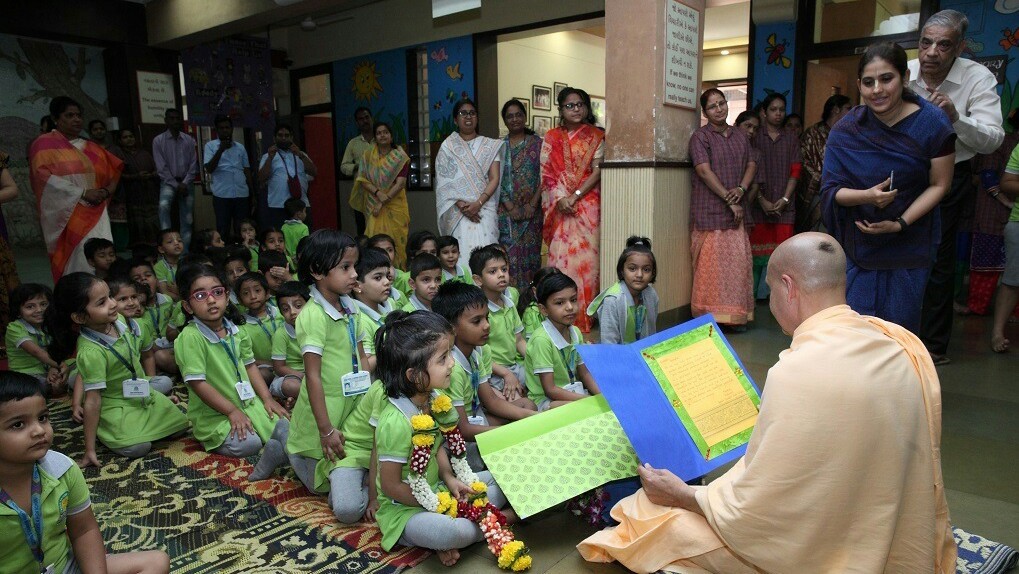
Children are the world’s most valuable resource and its best hope for the future. After unconditional love and attention, there may be nothing more powerful a parent can give a child than education. Education brings adult mentors who care about children, gives knowledge about health and the world, provides character-building experiences, and a sense of unity with the world.
Gopal’s Garden School aims to provide a loving environment suited for the best possible learning experience, where children are nourished with devotion and inspired with a will to work to become leaders of society, first class human beings, and devotees of the Lord.
Gopal’s Garden High School was established in July 2001 under the supervision of Radhanath Swami. It started in a rented flat with 9 children and 6 staff members, and today it has over 175 students. All teachers and staff are trained, have professional qualifications and good experience. The school is fully equipped with a library, a computer lab, a science lab, a sports room, a music room, and a counseling department. To inculcate spiritual culture in students, an aarti ceremony and a short Bhagvad Gita class is part of the school schedule.
